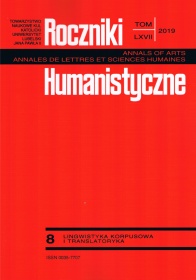Les dénominations polonaises et françaises des outils d’artisanat en tant qu’attributs des Saints et des Bienheureux dans l’iconographie
Abstract
The article contains an analysis of the attributes in iconographies of Saints, in particular tools, and their Polish and French names. In the first part the dictionary definitions of the word “attribute” are given, and then the indicated term “attribute” that designates essential elements of the form, is analyzed in relation to other terms and to the reality as designating elements in various fields over the centuries and now in informatics. In the following chapters – in historical perspective – attributes are described as identifiers of the presented figure in Christian culture and their classification according to form and subject. The criteria for their specification have been determined on the basis of the definition of “craft” included in the Polish Crafts Act and the organizational structure of the Polish Craft Association. The characterized groups of tools appearing as the attributes were illustrated with selected images of saints and blesseds from the 5th to the 13th century. For today’s man, the man of the digital era and robotics, more and more of these tools remain unknown, and their names become archaisms or are the subject of semantic evolution.
The article finishes with the reflection on the contemporary iconographic composition of saints, sometimes secondary to other techniques of perpetuating official images accompanying the beatification and canonization. In these icons written according to the iconographic pattern of the East, the decreasing role of individual attributes (including tools) and the meaning of the spiritual element symbolically expressed by universal and common attributes are observed.
References
Borrelli Antonio, San Feliciano dei Foligno. Vescovo e martire, http://www.santiebeati.it /dettaglio/90911 (consulté le 01-03-2019).
Butera Vittoria, 2003, San Foca l’ortolano, Falerna, Gezabele.
Carlo Ennio Morri, San Marino, http://www.santiebeati.it/dettaglio/68950, consulté le 01-03-2019.
Civil Pierre, 2005, « El artesano y el artista : aspectos de la iconografía de San José », Les Cahiers de Framespa [en ligne], no 1, http://journals.openedition.org/framespa/420, DOI : 10.4000/framespa.420, consulté le 06-03-2019.
Daniele Ireneo, San Dunstano. Monaco e vescovo, http://www.santiebeati.it/dettaglio/54050, consulté le 01-03-2019.
De Arriba Cantero Sandra, 2013, « San José », Revista Digital de Iconografía Medieval, vol. V, nº 10, 57-76, https://www.ucm.es/data/cont/docs/621-2013-12-14-07.%20San%20Jos%C3%A9.pdf, consulté le 01-03-2019.
Donati Andrea (curatore, traduttore e commentatore), 2010, « San Marino tra storia e leggenda da Omero a san Pier Damiani. Edizione critica della Vita sanctorum Marini et Leonis », [in :] Fonti, documenti, manoscritti, incunaboli, San Marino, L. Amati.
Dulewicz Andrzej, 2002, Encyklopedia sztuki niemieckiej, Warszawa, Wydawnictwo Naukowe PWN.
Federación Agustiniana Española, 2008, Santos y beatos de la familia agustiniana: subsidio litúrgico para el misal, Madrid: Federación Agustiniana Española.
Frejlich Andrzej, 1997, « Ikona », [in :] Encyklopedia katolicka, vol. 7, kol. 8-11, Lublin, Towarzystwo Naukowe KUL.
Fros Henryk, 1985, « Bernward », [in:] Encyklopedia katolicka, vol. 2, kol. 319, Lublin, Towarzystwo Naukowe KUL.
Blessed Theobald Roggeri. CatholicSaints.Info., 10 June 2017, https://catholicsaints.info/tag/ name-theobald/, consulté le 06-03-2019.
Guerra Chavarino Emilio, 2015, San Isidro, el códice, los milagros y el arca mosaica, vol. I [s. l.].
Kasperowicz Ryszard, 1997, « Ikonografia », [in :] Encyklopedia katolicka, vol. VII, 11-14.
Lanzi Fernando & Lanzi Gioia, 2003, Come riconosere i Santi e i patroni nell’arte e nelle immagini popolari, Milano, Ed. Jaca Booki SpA.
Lanzi Fernando & Lanzi Gioia, 2004, Jak rozpoznać świętych i patronów w sztuce i w wyobrażeniach ludowych, Kielce, Wydawnictwo Jedność.
Marecki Józef & Rotter Lucyna, 20132, Jak czytać wizerunki świętych, Kraków, Universitas.
Obrzędy Błogosławieństw dostosowane do zwyczajów diecezji polskich, 1994, Katowice, Księgarnia św. Jacka, nr 985, 83.
Pettiti Gianpiero, San Foca l Ortolano, http://www.santiebeati.it/dettaglio/71400, consulté le 01-03-2019.
Repetto José Luis, 2007, Todos los Santos. Santos y Beatos del Martirologio Romano, Madrid, Biblioteca de Autores Cristianos.
Rojo Martínez Fernando OSA, 2001, La seducción de Dios, Roma, Pubblicazioni Agostiniane.
San Reinaldo de Dortmunt. M. 960, http://hagiopedia.blogspot.com/2014/01/san-reinaldo-de-dortmund-m-960.html, consulté le 01-03-2019.
Sánchez Molledo, José María, 2009, « Iconografía de San Isidro Labrador y Santa María de la Cabeza » Pasos de Arte y Cultura, n. 9, 66-68, https://dialnet.unirioja.es/servlet/articulo ?codigo=3013947, consulté le 01-03-2019.
Santos y beatos de la familia agustiniana. Subsidio litúrgico para el Misal agustiniano, 2008, Madrid, [s. l.].
Święci na każdy dzień, 2009, Kielce, Wydawnictwo Jedność.
Vernier d’Oberwesel, https://fr.wikipedia.org/wiki/Vernier_d%27Oberwesel, consulté le 01-03-2019.
Werner Keber, San Varnerio (Werner) di Oberwesel Martire, http://www.santiebeati.it/ dettaglio/90238, consulté le 01-03-2019.
Wielki słownik języka polskiego PWN, 2018, Warszawa, PWN, t. 1.
Zibawi Mahmoud, 2018, Icone. Senso e storia, Milano, Ed. Jaca Book.
Copyright (c) 2019 Roczniki Humanistyczne

This work is licensed under a Creative Commons Attribution-NonCommercial-NoDerivatives 4.0 International License.





